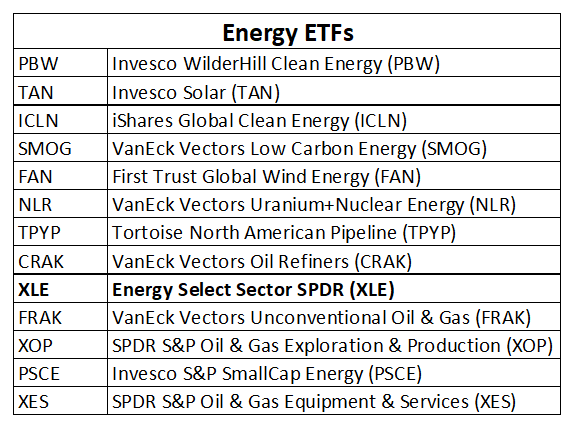The Wide(r) World Of Energy ETFs
The energy sector is a critical part of the US and global economy and this slice of global markets deserves a spot at the asset allocation table. But as an investment it’s been a disappointment in recent years… or has it?
Your definition of the energy sector matters… a lot. Although the conventional classification of energy stocks has fallen on hard times, this corner of equity markets encompasses a wide variety of companies beyond the standard choices. Conveniently, the sector’s rapid evolution in recent years has been captured to a large degree in ETFs.
ETFdb.com lists nearly 80 ETFs in the energy space and while the usual suspects populate the list there are also many portfolios that target the expanding array of alternative and niche industries. Energy equity beta, in other words, comes in many flavors, providing investors with a diverse set of risk factors via ETFs.
As a brief introduction into the possibilities, let’s review a subset of ETFs on ETFdb.com’s list and compare the results with what is arguably a conventional energy benchmark: Energy Select Sector SPDR (XLE), the largest energy ETF by far that’s dominated by the familiar big-oil names, including Chevron (CVX), ExxonMobil (XOM) and ConocoPhillips (COP).
The main investment theme for XLE and the biggest oil/energy stocks in recent history is an ongoing bearish trend. Over the past three years through yesterday’s close (Oct. 13), for example, XLE is down roughly 10% a year on an annualized basis vs. a 14%-plus annualized gain for US shares overall via SPDR S&P 500 (SPY).
The good news from a portfolio-design perspective is that XLE is far from the last word on energy stocks. Let’s explore this point in a bit more detail with a diverse set of energy ETFs and compare the results against the XLE benchmark.

The funds above represent a broad range of new and old energy industries. Not surprisingly, performance varies—dramatically. For instance, since the end of 2015, the top performer on our list is Invesco WilderHill Clean Energy (PBW), which has surged in recent years. A $1 investment in the fund at 2015’s close would have grown to more than $3 through yesterday’s close. By contrast, the same dollar invested in XLE over that span would be worth about 60 cents.

Ranking the funds above based on trailing 5-year returns reminds that the losses tend to be confined to the old energy business of fossil fuels.

Comparing the funds based with the standard risk metrics reminds that the energy sector comprises a wide-ranging opportunity set.

For a sense of how the components of the energy sector vary, the table below compares correlations for the ETFs. Note the broad range of results within the sector, dipping to as low as 0.36. Correlations range from 1.0, perfect positive correlation, to 0.0 (no correlation) to -1.0 (perfect negative correlation). The main takeaway: the potential for re-engineering energy beta risk is substantial by way of expanding the sector’s components.

The caveat is that the new world order of “clean energy” and other innovations, in all its various flavors, is a rapidly evolving realm. Using the recent past as a guide suggests that many of these corners are gold mines. But as in any new and emerging technology/industry, there will be winners and losers and so the potential for extreme results, for good and ill, will persist.
At the same time, it appears that the old business of fossil fuels that has defined the energy sector in decades past is now a sunset industry. Although no one should rule out the potential for extended rallies in big-oil stocks, the clock is ticking and so the potential opportunities for reinventing the energy sector is huge… as are the risks.
Disclosure: None.



